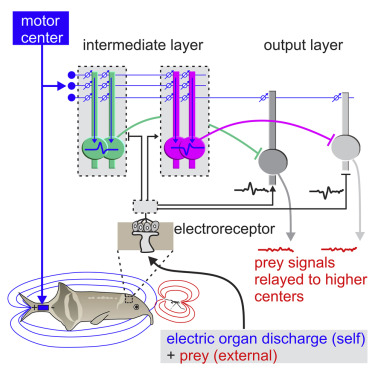Our official English website, www.x-mol.net, welcomes your feedback! (Note: you will need to create a separate account there.)
Continual Learning in a Multi-Layer Network of an Electric Fish.
Cell ( IF 64.5 ) Pub Date : 2019-11-14 , DOI: 10.1016/j.cell.2019.10.020 Salomon Z Muller 1 , Abigail N Zadina 2 , L F Abbott 3 , Nathaniel B Sawtell 2
Cell ( IF 64.5 ) Pub Date : 2019-11-14 , DOI: 10.1016/j.cell.2019.10.020 Salomon Z Muller 1 , Abigail N Zadina 2 , L F Abbott 3 , Nathaniel B Sawtell 2
Affiliation

|
Distributing learning across multiple layers has proven extremely powerful in artificial neural networks. However, little is known about how multi-layer learning is implemented in the brain. Here, we provide an account of learning across multiple processing layers in the electrosensory lobe (ELL) of mormyrid fish and report how it solves problems well known from machine learning. Because the ELL operates and learns continuously, it must reconcile learning and signaling functions without switching its mode of operation. We show that this is accomplished through a functional compartmentalization within intermediate layer neurons in which inputs driving learning differentially affect dendritic and axonal spikes. We also find that connectivity based on learning rather than sensory response selectivity assures that plasticity at synapses onto intermediate-layer neurons is matched to the requirements of output neurons. The mechanisms we uncover have relevance to learning in the cerebellum, hippocampus, and cerebral cortex, as well as in artificial systems.
中文翻译:

在电鱼的多层网络中进行持续学习。
在人工神经网络中,跨多层分布学习已被证明非常强大。但是,关于如何在大脑中实现多层学习知之甚少。在这里,我们提供了一个对跨虫鱼电感应叶(ELL)的多个处理层进行学习的说明,并报告了它如何解决机器学习中众所周知的问题。由于ELL持续运行和学习,因此它必须协调学习和信令功能,而无需切换其运行模式。我们表明,这是通过在中间层神经元内进行功能性区分开来实现的,其中驱动学习的输入差异地影响树突状和轴突突峰。我们还发现,基于学习而非感官反应选择性的连通性可确保突触到中间层神经元上的可塑性与输出神经元的需求相匹配。我们发现的机制与小脑,海马和大脑皮层以及人工系统中的学习有关。
更新日期:2019-11-14
中文翻译:

在电鱼的多层网络中进行持续学习。
在人工神经网络中,跨多层分布学习已被证明非常强大。但是,关于如何在大脑中实现多层学习知之甚少。在这里,我们提供了一个对跨虫鱼电感应叶(ELL)的多个处理层进行学习的说明,并报告了它如何解决机器学习中众所周知的问题。由于ELL持续运行和学习,因此它必须协调学习和信令功能,而无需切换其运行模式。我们表明,这是通过在中间层神经元内进行功能性区分开来实现的,其中驱动学习的输入差异地影响树突状和轴突突峰。我们还发现,基于学习而非感官反应选择性的连通性可确保突触到中间层神经元上的可塑性与输出神经元的需求相匹配。我们发现的机制与小脑,海马和大脑皮层以及人工系统中的学习有关。



























 京公网安备 11010802027423号
京公网安备 11010802027423号